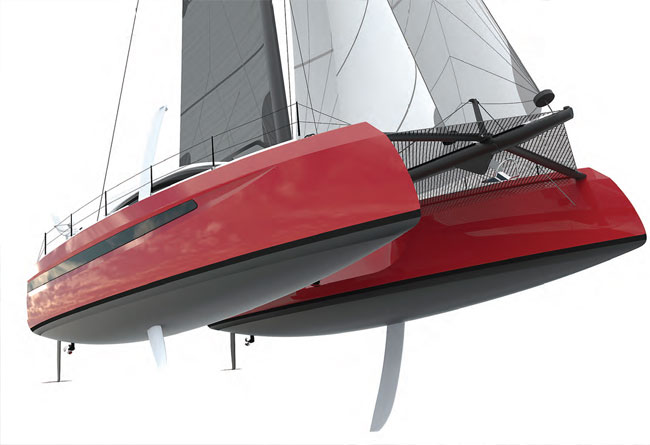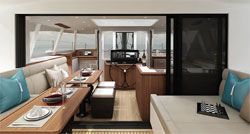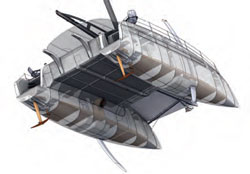

Bigger faster cats is where it’s at right now for many designers and builders. But the challenge of persuading three or four luxury cabins to proceed steadily upwind at 15-16kt is not one to be underestimated
The growing popularity of fast luxury catamarans can be easily seen not only at boatshows, but increasingly in harbours and marinas around the world as more people recognise the high value these craft represent in speed, comfort and ease of handling. For designers and builders the challenge is to find the balance between these key features as well as what the market requires in terms of style, utility and cost.
In catamaran design the process is not simple, since there are so many variables to account for: weight and trim, for example, are critical to control, given the narrow hull shapes, and the sail plan must be generous enough for adequate power in light air yet with systems to allow quick and easy depowering when needed. Appendages must also be carefully designed to be effective in all sailing conditions, easily adjustable for performance and safety, and ideally allowing these large yachts to access the shallowest anchorages
At the Hudson Yacht Group builder Paul Hakes, his son James, Elliott Thorne and the design team at Morrelli & Melvin have been successfully exploring these balances for a number of years now with their HH line of catamarans, starting first with the HH66 introduced in 2015, the HH55 introduced in 2016, and now the latest in the line, the new C-foil equipped HH48.
While this newest design incorporates in-house concepts articulated by James and Elliott, size matters and this 48-footer is not simply a scaled-down version of previous larger models. Instead the HH48 represents a new summation of lessons learnt through the design, construction and performance of the two bigger cats appropriate to a boat of this size.
For example, on deck the HH48 has sail and helm-handling features focused solely on shorthanded sailing, since it is envisioned that this boat will be appealing to families or couples with no professional crew onboard to help.
The systems are therefore designed to be intelligent – with push-button controls on the mainsheet and self-tacking jib as standard, plus an optional push-button powered system to raise and lower the C-shaped daggerboards. The launch of HH66 no5 prompted a rethink in sailing controls, with the addition of an alternate forward helm station; the design and build team’s focus moving on to combining the best of both worlds for future launches.
‘Being in the aft helm chair, flying along with the wind in your face and the sail controls at your fingertips and a balanced helm is an unparalleled sailing experience,’ says Hakes.
‘However, the forward cockpit and helm station is more comforting if things get rough, as you don’t have to go onto the side deck or cabin top to make sail adjustments. It’s also pretty comfortable for air-conditioned passage-making when it’s just too hot!’
The sail plan on the new HH48 comes standard with a nonoverlapping and self-tacking 44m2 staysail, a 95m2 mainsail reefable in three stops and a 122m2 fractional reacher. But to spice things up, a 70m2 Solent headsail is also offered, while for those going offshore a 10m2 storm jib completes the ‘oceanic’ package.
Mast height is generous at 23.7m off the water sitting only 1m short of the spar height on the HH55. This will be one fast feline in lightship trim of 10-11 tons, and still plenty pacey enough when fully loaded at 15-16 tons.
But the luxury cat market is sensitive not only to weight, but price as well, so to stay within the target production costs and fabrication times the interior layout of the HH48 has been kept intentionally simple: three or four cabin arrangement with a lot of the usual options included as standard, thus limiting the need for expensive and sometimes off-putting customisation.
’Offering a comprehensive selection of even well-considered options can deter the client so we design the best options in from the start, rather than having to build and then charge for more “custom” features. This allows us to produce better tooling for all standard structures,’ Hakes explained.
‘With fewer “add-on” parts to have to fabricate and retrofit we can mill these components to fit to within 1-2mm accuracy in the structures from the outset. It’s a win-win: there is less material needed, less fairing and finishing work, and the whole structure is stronger and faster to assemble. Perhaps most importantly, this approach – from customised design and building to standard production including what are normally options – allows us to introduce the pedigree and quality of an HH catamaran into a new larger market sector.’
At its massive production facilities in Xiamen, Hudson will build HH48s to CE and ISO standards using similar high-tech materials to their larger brethren, including infused E-glass-foamepoxy laminates for the hull, deck and PVC-cored bulkheads, with local carbon reinforcements in high-load areas, plus carbon stringers and frames. Core materials are thermoformed for more strength using PVC in the deck and Corecell M-foam for the hull bottoms and topsides. All the interiors are CNC cut, still using foam-cored furniture for added stiffness and low weight. (One option that does exist – for the ultimate performance-driven client – is to order your HH48 built entirely using infused carbon fibre construction!).

Above: given how fast these new large cats sail – and especially how efficient they are upwind compared to their ‘stodgy’ predecessors – the interior space available is extraordinary. Note also the forward inside helm position with the sail control pit just in front beyond the ‘windscreen’.
Below: multiple lightweight frames keep down the shell weight of the HH48 while T-rudders will both add confidence downwind in heavy airs and further reduce pitching. Faster boats, more comfortable motion… what’s not to like?

The HH48 hulls incorporate false bows in case of impact, and watertight bulkheads to seal off forward and aft compartments. The C-boards designed by Morrelli & Melvin use ideas they first explored working with Orace in the America’s Cup. Along with the rudders, these boards are built using higher modulus pre-preg carbon for maximum strength and reliability.
In a reversal of what has been seen during the last decade or so of industrialisation in China, Hakes says the country is now cracking down on environmental impact in most areas of industrial activity. In fact, the Hudson operation now meets and in some areas exceeds the emission standards required in Europe and elsewhere, with all extraction ventilation involving sophisticated filtration systems to remove dust and noxious fumes of any kind… (Working primarily with infused laminate pre-pregs also helps here of course.)
Another dust-free area at Hudson is crammed with computers and large flat-screen displays where the in-house designers and engineers produce drawings for the hundreds of parts found in an HH48. Having such a team in-house greatly speeds up the normal boatbuilding process.
‘Our office here of 20-plus engineers now do virtually all of the detailed design, then send it all to Morrelli & Melvin for review and approval,’ says James Hakes. ‘Doing it this way is much more streamlined and allows us to tailor the design to better fit with our desired production methods, but still meets their strict performance and quality standards. In the end this results in a boat that goes together better, is lighter, stronger and easier to build.’
But even with streamlined production that turns out a new HH48 every two months, the attention to detail in the HH48 matches the level of precision and finish quality seen in the company’s larger yachts and with the same respect for weight saving. Countertop surfaces in the full-fitted galley use lightweight cored panels veneered with Corian. In the main salon are more cored materials here with oak veneers mixed attractively with teak and maple. The navigation table, however, is in clear-coat carbon to remind you that this is a performance yacht!
The standard interior set-up has the owner’s quarters in the port hull, with the starboard hull laid out to accommodate two sets of guests in their own cabins. Other layouts are also available to taste.
Externally the HH48 has distinctive contemporary aesthetics with plenty of well-lit space in the main salon with large tinted windows, an overlap in the deckhouse roof to reduce direct sunlight, and generous light diffusion in the hulls through use of well-placed hatches and port lights
There is plenty of room for supplies for longer voyages and enough fuel tankage to give a range under power of 540nm at 9.5kt.
So, whether passage-making to get somewhere far away fast, casual coastal racing at the same speed as the wind, or just cruising, the HH48 is a tempting offer for the capable couple who prefer to get away from it all with a certain panache!
Click here for more information on HH Catamarans »
We invite you to read on and find out for yourself why Seahorse is the most highly-rated source in the world for anyone who is serious about their racing.
To read on simply SIGN up NOW
Take advantage of our very best subscription offer or order a single copy of this issue of Seahorse.
Online at:
www.seahorse.co.uk/shop and use the code TECH20
Or for iPad simply download the Seahorse App at the iTunes store


